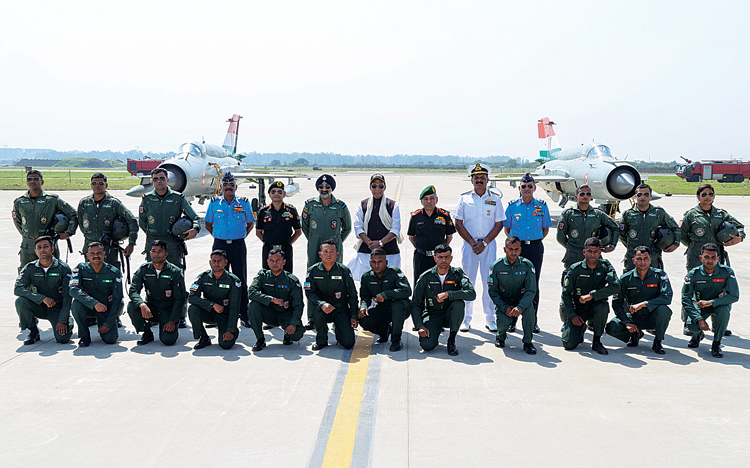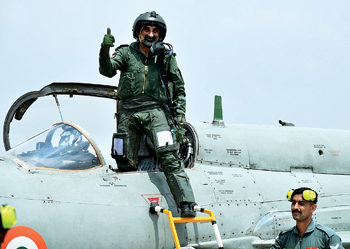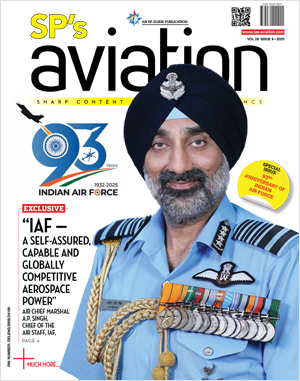INDIAN ARMED FORCES CHIEFS ON OUR RELENTLESS AND FOCUSED PUBLISHING EFFORTS

The insightful articles, inspiring narrations and analytical perspectives presented by the Editorial Team, establish an alluring connect with the reader. My compliments and best wishes to SP Guide Publications.

"Over the past 60 years, the growth of SP Guide Publications has mirrored the rising stature of Indian Navy. Its well-researched and informative magazines on Defence and Aerospace sector have served to shape an educated opinion of our military personnel, policy makers and the public alike. I wish SP's Publication team continued success, fair winds and following seas in all future endeavour!"

Since, its inception in 1964, SP Guide Publications has consistently demonstrated commitment to high-quality journalism in the aerospace and defence sectors, earning a well-deserved reputation as Asia's largest media house in this domain. I wish SP Guide Publications continued success in its pursuit of excellence.
- A leap in Indian aviation: Prime Minister Modi inaugurates Safran's Global MRO Hub in Hyderabad, Calls It a Milestone
- All about HAMMER Smart Precision Guided Weapon in India — “BEL-Safran Collaboration”
- India, Germany deepen defence ties as High Defence Committee charts ambitious plan
- True strategic autonomy will come only when our code is as indigenous as our hardware: Rajnath Singh
- EXCLUSIVE: Manish Kumar Jha speaks with Air Marshal Ashutosh Dixit, Chief of Integrated Defence Staff (CISC) at Headquarters, Integrated Defence Staff (IDS)
- Experts Speak: G20 Summit: A Sign of Global Fracture
The IAF’s MiG-21: Farewell to a Legend
For over three decades, from the 1970s to the 2000s, the MiG-21 was the backbone of the IAF, even as more advanced jets like the Mirage 2000, the MiG-29 and the Su-30 MKI were acquired


On October 8, as the Indian Air Force (IAF) looks back at its 93-year history with quiet satisfaction, one aircraft – the MiG-21 – will stand out from the rest. This fighter jet was remarkable, not just for its sheer weight of numbers, but for its amazing longevity. In fact, its 62 years of distinguished service with the IAF makes it the longest serving supersonic jet fighter in the inventory of any major Air Force of the world. For over three decades, from the 1970s to the 2000s, the MiG-21 was the backbone of the IAF, even as more advanced jets like the Mirage 2000, the MiG-29 and the Su-30 MKI were acquired. At its peak, the IAF operated 19 MiG-21 squadrons with around 400 aircraft.
The Mikoyan-Gurevich MiG-21 was designed in the Soviet Union purely as a supersonic interceptor, and armed only with air-to-air missiles, no cannon. It later morphed into a multirole combat aircraft with interceptor, fighter and ground strike capabilities. The Soviets wanted to fill the skies with thousands of cheap, lightweight, reliable jets. And they succeeded beyond their wildest dreams. Produced at around a third of the cost of comparable Western aircraft, capable of operating from rough airstrips, with frugal maintenance needs, yet packing a significant punch, it was grabbed by many less advanced countries. It ultimately became the most-produced supersonic jet in aviation history (11,496 aircraft) with over 60 countries having operated it during the 70 years after its first flight on June 16, 1955. China managed to reverse engineer the MiG-21 into the Chengdu J-7/F-7, building another 2,400 aircraft.


Not for nothing has the MiG-21 been called “the AK-47 of combat jets”. Its simple controls, engine, avionics, and weaponry were typical of Soviet military designs. It was smaller, faster, and nimbler than most fighters of the time. A pilot on operational readiness could get airborne in under two minutes. Thanks to its small size it was hard to spot visually. However, the shock cone in the front air intake was too small for a decent-sized radar and this made the aircraft highly dependent on ground control for effective interceptions. Its range and endurance were barely enough for a 45-minute mission. The delta wing configuration gave it excellent speed, acceleration and rate of climb, but also meant high landing speeds (around 340 km/h) and limited low-speed handling. In turning combat the aircraft bled speed rapidly. Consequently, experienced MiG-21 pilots learned to avoid turning engagements and, instead, would capitalise on the plane’s excellent thrust-to-weight ratio to take the fight into the vertical plane. The addition of a tail enhanced stability and control at the extremes of the flight envelope. The armament included one GSh 23 mm gun with 200+ rounds, plus four hard points capable of carrying fuel drop tanks, or combinations of bombs, rockets and missiles, for air combat or ground strikes.
In 1963, the MiG-21 became the first supersonic fighter to enter service with the IAF, with 28 Squadron Air Force, based at Air Force Station Chandigarh. The squadron naturally called itself the “First Supersonics”. As part of the deal, the Soviet Union offered India full transfer of technology and rights for local assembly. Hindustan Aeronautics Limited (HAL) set up factories at Nashik (airframe), Hyderabad (avionics), and Koraput (engines) and ultimately produced 657 of the IAF’s 840 MiG-21 jets in three variants: MiG-21FL, MiG-21M, and MiG-21bis. Thanks to extensive indigenisation and licence production, both production and maintenance costs were kept low, making it practicable for the IAF to maintain a large fleet for decades. Not content with simply reproducing copies of the original Soviet product, the IAF and HAL exploited the aircraft’s potential to the maximum through numerous modifications. These included the incorporation of better indigenous avionics systems developed by Bharat Electronics Limited (BEL) as well as much better weapons. Some MiG-21M aircraft were equipped with a Swedish Electronic Warfare (EW) system and transformed into dedicated EW aircraft. Others were fitted with British aerial reconnaissance cameras and employed in the Photo Reconnaissance (PR) role.
The MiG-21 is the IAF’s only fighter to have taken part in every operation from the 1965 conflict with Pakistan right till Operation Sindoor earlier this year. During the 1971 India-Pakistan conflict, MiG-21s played a leading role in both the western and eastern sectors. In the eastern sector, particularly, the aircraft was responsible for some highly successful steep glide bombing missions that cratered the runway at Tezgaon, the only operational Pakistan Air Force base in East Pakistan, rendering it inoperable. This gave the IAF air superiority across East Pakistan, and facilitated relatively unhindered ground, air, and naval operations for the rest of the conflict. MiG-21s also struck the Governor’s House in Dhaka, even as a high-level meeting was in progress there. This convinced the Pakistani leadership that India meant business and paved the way for speedy surrender.


Unfortunately, and rather unfairly, the MiG-21 gained the nickname “Flying Coffin” due to its high number of crashes. Although precise figures are hard to get, more than 400 MiG-21s were lost in crashes that claimed over 200 lives of pilots and people on the ground. Many factors contributed to the accidents, including the old airframe, critical deficiencies of spares consequent to the breakup of the Soviet Union, bird strikes and pilot error. Pilot error accidents were largely attributable to the decades-long delay in inducting an Advanced Jet Trainer (AJT). This delay forced young and inexperienced pilots to train on the MiG-21 – a role for which the aircraft was neither designed nor suitable. Probably no other major air force sent trainee fighter pilots straight from a low subsonic aircraft like the HJT-16 Kiran to a supersonic jet fighter. How did this happen? Blame it mainly on inadequate funding and official lethargy. The IAF was left with no choice but to persist with ageing MiG-21s, long after their expiry date. Still, taking into account the sheer longevity and numbers of the IAF’s MiG-21 fleet, its safety record was not that bad in comparison with other single engine fighter jets.
It was indeed fitting that the honour of operating the ultimate MiG-21 went to the IAF – arguably the world’s most experienced MiG-21 force. Around 125 MiG-21bis aircraft were upgraded to the MiG-21 Bison standard in the early 2000s. The MiG-21 Bison had a MiG-29 type bubble canopy, a superior radar, a helmet-mounted weapons sight, Vympel R-73 shortrange air-to-air missiles, and beyond-visual-range, fire-and-forget missiles. Just 36 MiG-21 Bison jets of 23 Squadron “Panthers” remained on the IAF’s inventory when the aircraft was officially retired on September 26, 2025. The closing ceremony was held at the Air Force Station, Chandigarh, the same base where the fighter had initially been inducted, thus marking a full circle for the IAF’s first supersonic jets.
In August, after his farewell solo sortie on the MiG-21 Bison, Air Chief Marshal A.P. Singh, Chief of the Air Staff (CAS), said, “It’s an amazing aircraft to fly, very agile and manoeuvrable... It will be missed by all who flew it.” ‘All who flew it’ includes practically every IAF fighter pilot of a certain period when the MiG-21 was the go to aircraft for every conceivable combat and training role. But now, a legend of the IAF has become history.





